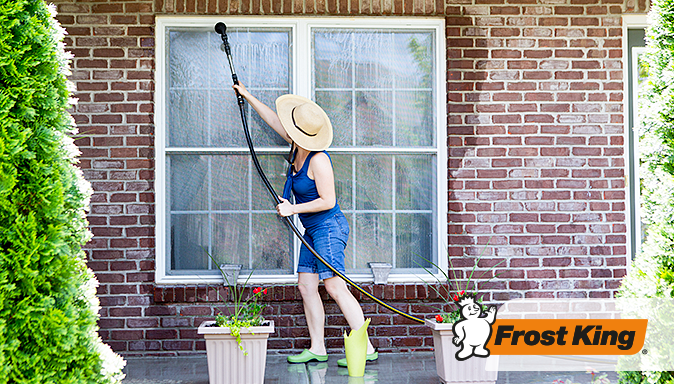Does it feel like you just recovered from the shocker of your winter heating bills? Well here comes the heat! Get control of cooling costs with some low-cost DIYs that really pay off.
Get Your Ducts in a Row
If you have a forced air HVAC system, air conditioning and heat is distributed throughout your house through ductwork that runs through your basement, crawl spaces, attics, and walls. It’s an efficient way to heat or cool your home—as long as the ducts are in good shape. Energy Star estimates that 20% of the air that moves through the typical duct system is lost to leaks, holes, and poorly connected ducts. Fortunately, this is a pretty simple DIY fix with our Foil-Backed “No Itch” Natural Cotton Duct Wrap. You just wrap the material around any exposed ducts and tape it in place to stop leaks and start saving on your energy bills. And because the insulating material is wrapped in soft, natural cotton, you don’t even need gloves, a face mask or goggles to get the job done.
Window Dressing
When was the last time you really cleaned your windows? We’re not talking about wiping down the glass with some window cleaner. We mean really getting in there and getting rid of any dirt and grime that collected in the frame and makes it hard to shut the window tightly? According to Energy Star, drafty windows are the top source of energy loss in your home—up to 25% or more!—so getting your windows into shape is a good way to save some cash.
• To start cleaning out the inside of your windows, open the window as wide as you can.
• Using the narrow nozzle attachment on your vacuum cleaner, suck up dirt, debris, dead insects and whatever else has accumulated in the window tracks, then sprinkle the tracks with baking powder.
• Spray a solution of equal parts vinegar and water over the baking soda and let it sit for about 10 minutes (the mixture will fizz and foam, just like it did in your favorite elementary school volcano science project.)
• Starting at the sides and working down, spray the tracks with more of the vinegar-water mixture then scrub with a small brush or old toothbrush. Repeat on the other side, then scrub the tracks at the base of the window.
• Grab a roll of paper towels and, starting at the sides again, wipe all the dirt down to the bottom of the track. You may have to push pretty hard to get into all the crevices. Repeat on the other side, and then wipe out the bottom track. You may need to spray and scrub the tracks again to get them sparkling clean.
While you’re working on the tracks, take a look around the window frame. Do you see any holes or gaps around the frame? Our Foam Tapes are a simple, no-mess way to fill small, energy-leaking gaps. Watch this video for step-by-step directions on how to choose and install the right foam tape for your windows.
A Clean Sweep
Did you know that a 1/8” gap at the bottom of a 3-foot wide exterior door can let as much outdoor air into your home as a 2.4-inch round hole in the wall? Adding one of our Door Sweeps to front, back and garage doors keeps hot air out and cold air in, and is one of the easiest projects you can do. Not only that, in the winter, the sweep will keep cold air from seeping into your living spaces and will keep insects and mice out all year long. Our EZ Clear Slide-On Door Bottom fits most standard-sized doors and couldn’t be easier to install: watch this video to see how.
After installing the sweep, give the door a quick once-over to check for gaps, which can be sealed with foam tape the same way you sealed gaps around your windows or with our mess-free Mortite Fingertip Rope Caulk. You just pull off what you need and push it into the cracks. Watch this video to see how.
Each of these quick and easy home improvement projects can be done in an afternoon and will pay off in lower cooling bills all summer long.
